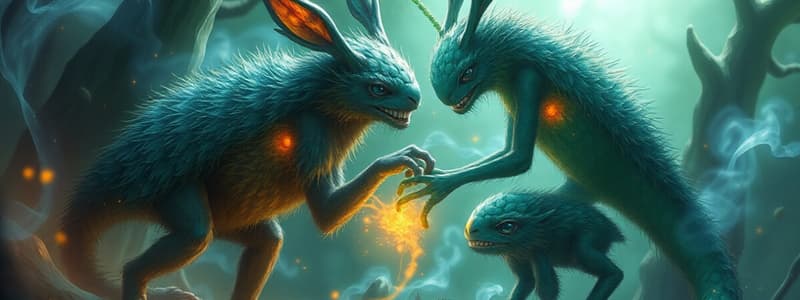Podcast
Questions and Answers
What type of symbiotic relationship is described when both species benefit from the interaction?
What type of symbiotic relationship is described when both species benefit from the interaction?
- Commensalism
- Mutualism (correct)
- Parasitism
- Predation
In commensalism, both species benefit from the interaction.
In commensalism, both species benefit from the interaction.
False (B)
What is the term for the living partnership between different species?
What is the term for the living partnership between different species?
symbiosis
The relationship where one organism benefits at the expense of another is called __________.
The relationship where one organism benefits at the expense of another is called __________.
Match the following types of symbiotic relationships with their definitions:
Match the following types of symbiotic relationships with their definitions:
Which example illustrates mutualism?
Which example illustrates mutualism?
Symbiosis always requires both organisms to benefit.
Symbiosis always requires both organisms to benefit.
Provide one example of mutualism involving plants.
Provide one example of mutualism involving plants.
The clownfish ____ the anemone by cleaning it and providing nutrients.
The clownfish ____ the anemone by cleaning it and providing nutrients.
Which of the following statements about symbiosis is true?
Which of the following statements about symbiosis is true?
What do honey bees collect from flowers?
What do honey bees collect from flowers?
Plover birds harm crocodiles while eating food from their jaws.
Plover birds harm crocodiles while eating food from their jaws.
What do zooxanthellae provide to coral polyps?
What do zooxanthellae provide to coral polyps?
The symbiotic relationship between coral and zooxanthellae is primarily based on the exchange of __________ and __________.
The symbiotic relationship between coral and zooxanthellae is primarily based on the exchange of __________ and __________.
Match the following animals with their symbiotic relationships:
Match the following animals with their symbiotic relationships:
In mutualism, how do both species benefit?
In mutualism, how do both species benefit?
Commensalism is a type of symbiotic relationship where one species benefits and the other is harmed.
Commensalism is a type of symbiotic relationship where one species benefits and the other is harmed.
Name one mutualistic relationship involving bacteria.
Name one mutualistic relationship involving bacteria.
The __________ bird eats insects from the skin of the zebra, benefiting both.
The __________ bird eats insects from the skin of the zebra, benefiting both.
Which of the following is NOT a type of symbiotic relationship?
Which of the following is NOT a type of symbiotic relationship?
Flashcards
Symbiosis
Symbiosis
A close and long-term interaction between two species, where at least one benefits.
Mutualism
Mutualism
A symbiotic relationship where both species benefit from the interaction.
Commensalism
Commensalism
A symbiotic relationship where one species benefits and the other isn't affected.
Parasitism
Parasitism
Signup and view all the flashcards
Oxpeckers and Cattle
Oxpeckers and Cattle
Signup and view all the flashcards
Clownfish and Anemones
Clownfish and Anemones
Signup and view all the flashcards
Mistletoe Birds and Plants
Mistletoe Birds and Plants
Signup and view all the flashcards
Mammal Guts and Bacteria
Mammal Guts and Bacteria
Signup and view all the flashcards
Symbiont
Symbiont
Signup and view all the flashcards
Ecological Relationship
Ecological Relationship
Signup and view all the flashcards
Symbiotic Relationship
Symbiotic Relationship
Signup and view all the flashcards
Coral-Zooxanthellae
Coral-Zooxanthellae
Signup and view all the flashcards
Mutualism
Mutualism
Signup and view all the flashcards
Oxpecker-Zebra
Oxpecker-Zebra
Signup and view all the flashcards
Sea Anemone-Clownfish
Sea Anemone-Clownfish
Signup and view all the flashcards
Mistletoe-Bird
Mistletoe-Bird
Signup and view all the flashcards
Honeybee-Flower
Honeybee-Flower
Signup and view all the flashcards
Crocodile-Plover
Crocodile-Plover
Signup and view all the flashcards
Koala-Bacteria
Koala-Bacteria
Signup and view all the flashcards
Symbiosis Types
Symbiosis Types
Signup and view all the flashcards
Study Notes
Ecological Relationships
- Symbiosis is a close, long-term interaction between different species, benefiting at least one.
- Each species involved is called a symbiont.
- Mutualism, commensalism, and parasitism are examples of symbiotic relationships.
Mutualism
- Mutualism is a partnership where both species benefit.
- Oxpeckers feed on parasites on large animals like cattle, benefiting both. The large animal benefits from parasite removal, and the oxpecker gets food.
- Cleaner fish and shrimp remove parasites from larger marine animals, benefiting both.
- Bees get nectar from flowers and distribute pollen, benefiting both species.
- Plovers birds eat from crocodiles' mouths, removing debris while the crocodile gets its teeth cleaned.
- Coral polyps and zooxanthellae (algae): Coral provides a safe environment and carbon dioxide for algae. Algae provides the coral with glucose (food) and oxygen.
- Mistletoe birds and mistletoe plants: Birds eat the fruits, disperse seeds, while the plant gets dispersed, and new plants grow.
- Koalas and bacteria in their digestive systems: Koalas have a long caecum with millions of bacteria that break down tough plants.
Symbiotic Relationships: Example Types
- Coral and zooxanthellae
- Oxpeckers and zebras
- Sea anemones and clownfish
- Mistletoe birds and mistletoe plants
- Honeybees and flowering plants
- Crocodiles and plover birds
- Koalas and bacteria in their digestive system
Studying That Suits You
Use AI to generate personalized quizzes and flashcards to suit your learning preferences.




